A B C D E F G H I J K L M N O P Q R S T U V W X Y Z
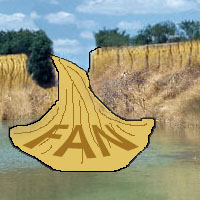
Alluvial Fan A fan-shaped deposit of sediment that forms where a stream drops downward from a higher elevation and encounters the valley floor. The stream slows down, depositing fine silt, sand, or other sediments it is carrying.
American Indian Indian was the name mistakenly used by early European explorers for the indigenous people living in North and South America. The explorers thought they had found India. But the mistake stuck and now the term Indian means "Native American." Some Native Americans do not like the term Indian. Most American Indians or Native Americans prefer to be known by their tribal name, such as Caddo or Comanche.
Archeology/Archaeology Scientific study of the human past through the things left behind by humans, including artifacts, remains of shelters or buildings, campsites, cooking areas, and other traces of their lives.
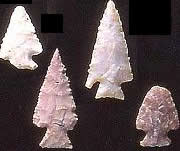
Arrowhead An arrowhead is the same thing as an arrow point. It is the sharp tip of an arrow, the part that spears the target. In precontact times arrow points were made out of stone. In more recent times, most arrow points were made of metal. Arrowheads were attached to the end of a wooden or cane shaft, using strong fiber or leather cording and sometimes mastic (glue) to hold them in place.
Artifact Something made or used by a person in the past, such as tools, containers, and weapons, as well as the bits and pieces (debris) left over from making these things. Archeologists often learn just as much from tiny, broken pieces as they do from whole artifacts. Even an animal bone is considered an artifact if it was used or modified by a human. Archeologists look for cut marks on bone, for instance, to show human use.
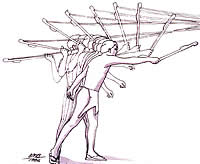
Association Archeological term used to describe objects found together. When artifacts or other objects are found together or close by, they are said to be "associated" or "found in association" with one another. This may mean that the items were used together. Bones, stones, charcoal, and ash found together ("in association") may be the remains of a cooking hearth where meat was cooked.
Atlatl Short, hand-held piece of wood used as a lever to "throw" or propel a dart or light spear. This is an Aztec word pronounced "at-lat-til" or "at-til-lat-il". Atlatl technology predated bow and arrows, and were used around the world for thousands of years.

Bison Scientific name for buffalo.
Buffalo Cow-like animal with a dark shaggy hide and short curved horns; also called bison. Millions of buffalo once roamed the Great Plains in the central part of North America. When white settlers moved into the area, hide-hunters used powerful rifles to kill thousands and thousands of buffalo. Within a few years, almost all the buffalo were gone (and in danger of becoming extinct). Fortunately, a few were saved by thoughtful ranchers. Today, the buffalo are becoming numerous again.
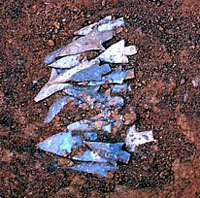
Cache A group of hidden items found in a tight cluster indicating they were intentionally buried or placed together. Native peoples sometimes buried caches of tools or weapons at campsites, perhaps to use on future visits. They also placed caches of finely made items in the graves of loved ones.
Chert A type of sedimentary rock, also called "flint." American Indians used chert to make stone tools such as dart points. Chert flakes and tools can be incredibly sharp.
Chronology A system used to organize events and other information, from earliest to latest, in a time line. Archeologists develop cultural chronologies to help understand how cultures change through time.

Climate The long-term weather conditions, or patterns, in a particular region including the amount of rainfall and temperature. (For example, West Texas has an arid, or dry, climate.)
Clovis Name given to the earliest known groups of people in North America. They are known for their distinctive spear points. Clovis peoples hunted big-game animals—mammoths and Ice Age horse—and smaller creatures, such as turtles, as well. They probably also ate a variety of plants.
Colluvium Loose sediment that accumulates at the base of a hill or cliff due to gravity.
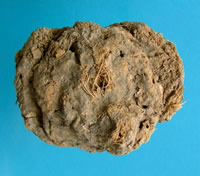
Context An artifact's physical context is exactly where it is found within a site. To understand an artifact's context, the archeologist must study the site's stratigraphy (layering of dirt and soil), where other artifacts and features in the site are located, and the site's setting.
Coprolite Dried feces of prehistoric people (in other words, prehistoric poop!).
Culture Knowledge about life and traditions that we learn from our parents, friends, and community that are passed on to our children (and then their children). An example of American culture: we celebrate birthdays with parties, cakes, and candles. Some cultures don't; They may have other celebrations or rituals that we don't share.
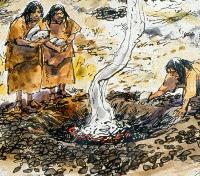
Dart point A sharply pointed piece of stone shaped by skillful chipping. The dart point is attached to the tip of a dart (light spear) thrown with an atlatl.
Data Information, usually specific scientific information such as measurements or other observations. Singular is datum.
Earth oven Layers of coals, heated rocks, food (especially roots and hearts of agaves) and green plants used to keep the food clean and provide moisture. A thick layer (or cap) of earth seals in the steamy heat. Earth ovens often cooked for two or three days in a row because the plants had to cook a long time before they were tender enough to eat.
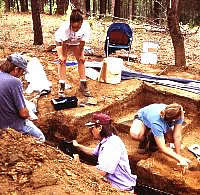
Excavate To uncover (dig) and document (map and take notes about) artifacts and sites of the human past in a careful, planned way.
Extinct Usually refers to types of animals or plants that have died out. In North America, many large mammals became extinct at the end of the last Ice Age about 12,000 to 14,000 years ago.
Fauna All the animals of a particular region or time period, considered as a group. For example, the fauna of south Texas in prehistoric times included pronghorn antelope and bison as well as white-tailed deer, rabbits, and many other animals, from frogs to fish.

Feature Distinctive patterns of related things that often represent individual events and that stand out in contrast to their surroundings. For instance, stones found in a circle with bits of charcoal and burned animal bone may be hearths or cooking features where people cooked a meal.
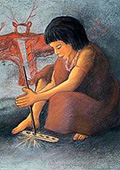
Fire drill A two-part wooden tool for starting fires. A wooden stick is rapidly twirled in a hole in a piece of wood (fire hearth). When twirled long enough, the friction causes the stick to heat up and make a spark, which starts a fire when it is placed on a small bunch of dried grass, crushed bark, or other flammable tinder.
Flint See Chert.
Geology The scientific study of the history and structure of the earth and its rocks and minerals. Archeologists use methods and techniques from geology to learn about the sites and environment in which ancient people lived.
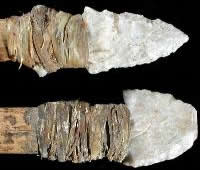
Hafted Attached to a handle or shaft. Stone arrow points and other tools were hafted in a notch or slot on a stick or shaft. The tool was held tightly in place by using a sticky glue (like tree resin) or by wrapping it with cord made of fiber or animal sinew.
Hamlet A cluster of houses forming a small village. The Caddo Indians of East Texas lived in hamlets as well as larger villages. (Question: Did people living in hamlets eat omelettes?)
Hearth A campfire or cooking area often marked by a circle or cluster of fire-cracked rocks. Native people built hearths for cooking and for warming themselves.
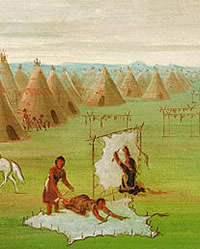
Hide tanning The process in which animal hide is converted into leather. American Indians used this process in order to create longer-lasting, more durable clothing. The first step in this procedure was to remove the skin from the animal. After scraping away the remaining flesh and removing the hair, women set the hide in the sun to dry. To complete this operation the hide was treated with tannin, which made it softer, yet stronger. American Indians had several sources of tannin. A commonly used source was campfire ashes which were mixed with water.
Historic Period The period of history covered in written records. In Texas, the historic period began in the mid-1500s with the coming of the first Spanish explorers.
History Chronicle (true stories) of what happened in the human past, usually a written account. Oral histories are those that are passed on from person to person as memorized stories, told out loud.
Holocene The name for the geologic time period beginning about 11,000 years ago at the end of the last Ice Age.
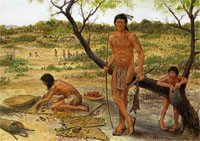
Hunting and Gathering A way of life in which people obtained food and all the other resources they needed directly from the land. For thousands of years, people hunted animals and gathered plants in the wild, instead of growing crops or raising animals such as cattle. They did not have grocery stores for food, or hardware stores for tools, like we do today. In some places people still practice a hunting and gathering lifestyle.
Hypothesis An educated guess used as a trial explanation. That means the hypothesis is used until the archeologist knows "for sure" that they are right (or at least pretty sure!). Remember, archeologists hardly ever know anything for sure. Instead, they just try to make really intelligent guesses about things that happened a very long time ago—long before they were alive. So instead of making a wild guess, the archeologist is using knowledge and training to help make an educated or "smart" guess.

Here's an example. If your mom wasn't home but you saw the car was still in the driveway, you might guess that she was taking the dog for a walk. Would that be a wild guess? READ MORE
Ice Ages Periods of time where ice sheets, or glaciers, covered most of the earth. The height of the last Ice Age in North America was 18,000 years ago and ended in the late Pleistocene.
Indigenous Another word for native or aboriginal. When used to refer to people, indigenous means a group, or their descendants, who lived in a given place before contact with explorers or colonists. Unlike the North America specific terms American Indian and Native American, indigenous can refer to people around the world.
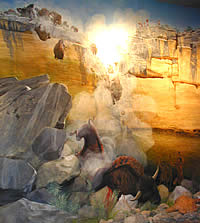
Inference A conclusion made from evidence. For example, if you found charcoal, ashes, and burned animal bones together, you might infer that this was the scene of a cooking fire. Archeologists use their training and imagination to decide what clues (evidence) tell us about human history. Their conclusions are called inferences.
Jump site A place where American Indians herded hundreds of buffalos over a cliff or high bluff in order to kill many animals at once.
Knap Chipping and shaping stone (such as flint or chert) to make tools, like arrow heads.

Lithic Pertaining to stone. In prehistoric times, people used lithics to make tools and weapons.
Lower Pecos Canyonlands The name used to describe the desert-like area along the Pecos River in far southwest Texas. American Indian peoples lived in rockshelters along the river and left behind tons of trash, such as food, clothing, baskets, and tools, that archeologists can study. The dry climate of the region has preserved the artifacts, unlike in humid areas where most fiber and bone artifacts decay and disappear.
Mano and metate A pair of tools used together to grind up corn, seeds, and many other things. "Mano" means "hand" in Spanish. In this case, a mano is a round stone held in your hand and rubbed against a larger, flat or concave rock with a worn spot in its center called a metate. You could say that a mano and metate were used like our kitchen blenders!

Megafauna Large North American animals that lived during the last Ice Age (Pleistocene Era) and became extinct around 10,000 years ago. Scientists think either human hunting or climatic change, or both, led to the disappearance of these animals. Texas megafauna included mastodons, giant sloths, horses, camels, wolves, lions, and bison.
Midden A trash pile, especially kitchen trash—animal bones, ashes, charcoal, broken dishes, and all sorts of other junk that gets thrown away. Middens formed near or around cooking places, which is to say, near where people lived. Because of all the organic (natural) matter —rotting plant parts, bone, etc. —middens usually have very dark soil. Many American Indians used hot rocks (rocks heated in the fire) to cook certain foods, so their middens often contain lots of burned rocks cracked by the fire's heat. Some of the most interesting things archeologists find are discovered in middens!

Mission A specific area containing a chapel (church), houses, and workshops organized by Spanish Catholic priests to spread their faith. Local American Indian groups often lived at or in association with missions during the historic period.
Native American Synonymous with American Indian.
Nomads People who moved from place to place, usually in search of food or other resources. Many prehistoric peoples lived a mobile lifestyle, moving every few days or weeks or months to new camping spots where more game, food plants, firewood, or other resources were available
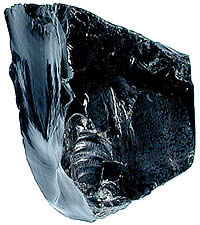
Obsidian A translucent glass-like stone ("volcanic glass") that American Indians chipped into tools and weapons. The rock does not come from Texas, but other areas to the north and west, such as Idaho and New Mexico. It is usually black (but sometimes brown, reddish, or greenish) and is always very sharp!
Ocher Iron-rich minerals in red and yellow tones used by native peoples as pigment. People all over the world have used ocher pigment for thousands of years for body decoration, art work, and in ceremonies. Red ocher, which may have symbolized blood, was often used in human burials.
Paleoindian Term used to describe the earliest Native Americans. They lived in North America as early as 13,500 years ago. "Paleo" means old.
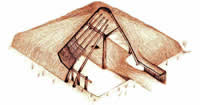
Pithouses Built by prehistoric people on the Texas plains, pithouses were very well suited for the plains environment, as they took advantage of the natural insulation provided by the earth. The first stage of building such a house was to dig a pit. A frame made of wood logs and branches would be built, and then the earth (dirt) dug out of the pit was often used to make the roof. Early pioneers in the Texas Panhandle built dugouts that were very similar to prehistoric pithouses. Even today, some residents of the Panhandle build underground homes because they are energy efficient and protect people from severe weather better than any above-ground dwelling.
Pleistocene A geologic term used to describe the time period from about 1.8 million to about 11,000 years ago. During this time megafauna including wooly mammoths, saber tooth cats, and giant sloths roamed across Texas and North America. These animals are now extinct.
Precontact The time before contact with European exploration and colonial settlement of an area, often used interchangeably with Prehistory (defined below).
Prehistory The time before written history. Writing came into use in different areas of the world at different times. For example, the Zapotecs, a Mesoamerican civilization, had a writing system over 2,000 years ago. At the same time in history, the Native people in Texas did not have writing.

American Indians have history—before colonization their histories were spoken aloud (oral histories) and remembered, and passed down to children, grandchildren, and so on through the generations. Many American Indian histories are still shared in this manner, and many have been written down as well.
Preserve To protect artifacts and sites for the future by preventing looting (stealing) and vandalism (damage).
Presidio Small fort in which Spanish soldiers were stationed. Often presidios were built near missions to protect the Spanish priests and American Indians living there.
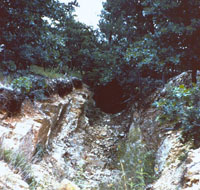
Projectile point Another term for a spear point, dart point or arrowhead.
Quarry Places where people dig out (or quarry) stone for various uses. Ancient peoples found places where good quality stones were concentrated. They dug up stone to make into tools and weapons, such as dart and arrow points.
Quids The chewed leaf parts from certain plants cooked by prehistoric peoples. Once plants such as yucca, sotol, and lechuguilla were cooked, prehistoric people chewed the sugary, nutritious food off the leaf bases. Then they would spit out the wads of fiber, called quids.

Radiocarbon dating An age estimate based on the amount of a natural radioactive carbon isotope (carbon-14) that remains in any organic matter (formerly living things such as bone or plants or material made from living things such as cloth and leather).
Rancheria Spanish word that means temporary village or hamlet.
(See the Graham-Applegate exhibit).
Ritual A special ceremony or religious observance. Native Americans took part in many rituals as part of their belief system.
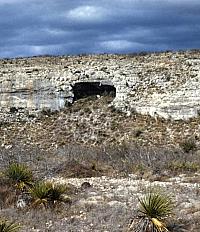
Rock art Paintings and carvings done by Native Americans on boulders, cliff faces, and cave walls. While the colorful paintings are often very artistic, most were done as part of a ritual (a celebration or religious service), not just to create something interesting to look at.
Rockshelter Shallow caves or overhangs formed in cliffs. Precontact American Indians often camped in rockshelters because they offered protection from the winter winds and rain and were cool and shady in the summer.
Sedentary Describes people who stayed in one place, such as in a village, most of the time, rather than people who moved from place to place (see Nomads).
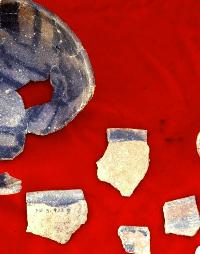
Shaman A member of certain Native American tribes who serves as magician, healer of the body and spirit, keeper of traditions, and artist.
Sherds Pieces of pottery vessels (like clay pots). It is common for an archeologist to find sherds at site where people used pottery. Pottery was used for many purposes including cooking, holding water, and collecting food. Because dried clay is so fragile, it easily breaks into sherds. Because of this, finding a whole pottery vessel (even with cracks or chips) is very unusual!
Site A place where people in the past lived or stopped to do something long enough to leave behind evidence (like artifacts, middens and firepits) that shows they had been there. Prehistoric sites are those created before written history—like ancient American Indian campsites. Historic sites are those that aren't from as long ago. Some famous historic sites you might know about are the Alamo, the shipwreck of the Belle, and Washington-on-the-Brazos (Texas' first capitol).

Stratigraphy The study of the natural and cultural layers that make up an archeological site. Archeologists study these layers of deposits (soil and sediments) to understand the processes by which the site was formed, including flood deposits, ancient camp litter, and wind-blown sand. Generally, younger layers are deposited on top of older layers. In geology, stratigraphy is the study of layers of rock, including their geographic extent, age, classification, characteristics and formation.
Stratum (plural: strata) A distinct natural or human-made layer. For geologists, the textbook example of strata is successive horizontal layers of rock arranged like a layer cake. The strata that archeologists often encounter, however, are rarely so neat and often inclined, irregular, intermixed or otherwise challenging to trace. See Stratigraphy (above).
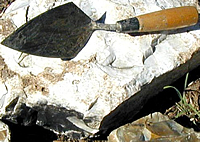
Trowel A small hand-held digging tool like the one Dr. Dirt holds. Trowels are essential archeological excavation tools.
Ungulate An animal with hoofs. Pronghorns (antelopes), deer, bison, and javelina are examples of wild ungulates. Cows, horses, goats, and pigs are examples of domesticated ungulates. Hoofs help animals walk or run over grasslands.
Vandalize To destroy or damage artifacts or sites.
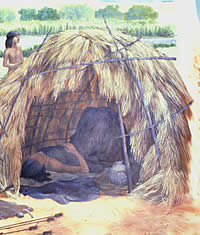
Wickiup A small, temporary shelter used by prehistoric peoples for camping. Made of tree branches and covered with bundles of grass or reeds, a wickiup (pronounced wicky-up) provided protection from the wind and rain and shade from the glaring sun.
Winnow A method of separating seeds from dirt and other plant material, so that the seeds can be used as food. Plant materials were first placed in a flat basket or tray and then tossed gently in the air on a windy day. The lighter leaves and dust would be blown away, while the heavier seeds would drop back into the basket.
Xerophyte Plants which require little water to live, such as cactus.
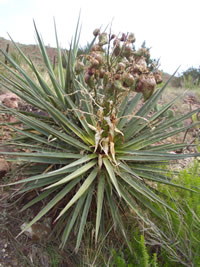
Yucca A desert plant with sharply pointed leaves found throughout Texas and the southwest. American Indians ate many parts of the yucca and similar plants. They dug out the base of the plant (called the heart) and cooked it for several days in an earth oven with hot rocks. Learn more about hot rock cooking and other thorny plants used for food in What’s for Dinner?
Zone A term used for a stratigraphic layer or an area of related strata in an excavation. See Stratigraphy.
